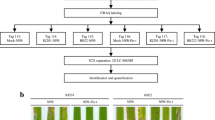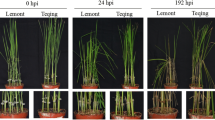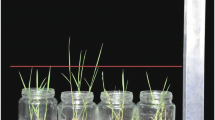Abstract
Benzothiadiazole (BTH) is an artificial inducer of systemic acquired resistance. Due to rice being an important food crop and model plant, we investigated its response to BTH using label-free proteomics technology coupled with bioinformatics. Protein expression levels were verified using the multi-reaction monitoring mode and semi-quantitative RT-PCR. BTH treatment can up- or down-regulate many proteins produced by the rice host at all four periods, with the numbers of proteins being 6/24, 9/10, 14/10, and 8/20, respectively. Compared with mock treatments (phosphate buffered saline with 0.1 % dimethylsulfoxide and 0.5 % Tween-20), some proteins related to plant resistance were only detected after BTH treatments, such as ascorbate peroxidase (POD) 3, chitinase A, thioredoxin-dependent POD 2, beta-1,3-glucanase 2, POD superfamily protein, major facilitator superfamily (MFS) protein, copper/zinc-superoxide dismutase (SOD) 1, pathogenesis-related protein (PR) 1. Other proteins showing up-regulation after BHT treatment included PR-5, glyceraldehyde-3-phosphate dehydrogenase C, plasma-membrane associated cation-binding protein 1, and oxidoreductase family proteins. These results indicated that BTH was involved with inducing rice resistance. Some up-regulated proteins were also involved in other metabolic processes. The activity and expression level of POD, phenylalanine ammonia-lyase (PAL), and SOD, lipoxygenase (LOX), beta-1,3-glucanases, and chitinases were determined using the enzyme activity assay and semi-quantitative RT-PCR. These results indicated that BTH can enhance the activity of beta-1,3-glucanases, LOX, PAL, and POD. BTH can also induce up-regulation of the copper/zinc-SOD, ascorbate POD, glutathione POD 1, Chitinase, and LOX1 genes.








Similar content being viewed by others
References
Abeles FB, Bosshart RP, Forrence L, Habig WH (1971) Preparation and purification of gluanase and chitinase from bean leaves. Plant Physiol 47:129–134
Barceló-Batllori S, Kalko SG, Esteban Y, Moreno S, Carmona MC, Gomis R (2008) Integration of DIGE and bioinformatics analyses reveals a role of the antiobesity agent tungstate in redox and energy homeostasis pathways in brown adipose tissue. Mol Cell Proteomics 7(2):378–393
Bernacchia G, Schwall G, Lottspeich F, Salamini F, Bartels D (1995) The transketolase gene family of the resurrection plant Craterostigma plantagineum differential expression during the rehydration phase. EMBO J 14:610–618
Boller T, Mauch F (1988) Colorimetric assay for chitinase. Methods Enzymol 161:430–435
Bowles DJ (1990) Defense-related proteins in higher plants. Annu Rev Biochem 59:873–907
Brinkmann H, Martinez P, Quigley F, Martin W, Cerff R (1987) Endosymbiotic origin and codon bias of the nuclear gene for chloroplast glyceraldehyde-3-phosphate dehydrogenase from maize. J Mol Evol 26(4):320–328
Brisset MN, Cesbron S, Thomson SV, Paulin JP (2000) Acibenzolar-S-methyl induces the accumulation of defense-related enzymes in apple and protects from fire blight. Eur J Plant Pathol 106:529–536
Chen Z, Zeng MJ, Song BA, Hou CR, Hu DY, Li XY, Wang ZC, Fan HT, Bi L, Liu JJ, Yu DD, Jin LH, Yang S (2012) Dufulin activates HrBP1 to produce antiviral responses in tobacco. PLoS ONE 7(5):e37944
Chen Z, Guo Q, Chen BH, Li XY, Wang ZC, He P, Yan F, Hu DY, Yang S (2014) Development of proteomic technology of shotgun and label free combined with multiple reaction monitoring to simultaneously detect southern rice black-streaked dwarf virus and rice ragged stunt virus. Virusdisease. doi:10.1007/s13337-014-0195-y
Chopra S, Ramkissoon K, Anderson DC (2013) A systematic quantitative proteomic examination of multidrug resistance in Acinetobacter baumannii. J Proteomics 84:17–39
Chun HJ, Park HC, Koo SC, Lee JH, Park CY, Choi MS, Kang CH, Baek D, Cheong YH, Yun DJ, Chung WS, Cho MJ, Kim MC (2012) Constitutive expression of mammalian nitric oxide synthase in tobacco plants triggers disease resistance to pathogens. Mol Cells 34(5):463–471
Durrant WE, Dong X (2004) Systemic acquired resistance. Annu Rev Phytopathol 42:185–209
Friedrich L, Lawton K, Ruess W, Masner P, Specker N, Rella MG, Meier B, Dincher S, Staub T, Uknes S, Metraux JP, Kessmann H, Ryals J (1996) A benzothiadiazole derivative induces systemic acquired resistance in tobacco. Plant J 10(1):61–70
Giannopolitis CN, Ries SK (1977) Superoxide dismutase. I. Occurrence in higher plants. Plant Physio1 59:309–314
Görlach J, Volrath S, Knauf-Beiter G, Hengy G, Beckhove U, Kogel KH, Oostendorp M, Staub T, Ward E, Kessmann H, Ryals J (1996) Benzothiadiazole, a novel class of inducers of systemic acquired resistance, activates gene expression and disease resistance in wheat. Plant Cell. 8(4):629–643
Hammerschmidt R, Nuckles EM, Kuć J (1982) Association of enhanced peroxidase activity with induced systemic resistance of cucumber to Colletotrichum lagenarium. Physiological Plant Pathology 20(1):73–76
Huh WK, Kim ST, Yang KS, Seok YJ, Hah YC, Kang SO (1994) Characterisation of D-arabinono-1, 4-lactone oxidase from Candida albicans ATCC 10231. Eur J Biochem 225(3):1073–1079
Hukkanen A, Kokko H, Buchala A, Häyrinen J, Kärenlampi S (2008) Benzothiadiazole affects the leaf proteome in arctic bramble (Rubus arcticus). Mol Plant Pathol 9(6):799–808
Inbar M, Doostdar H, Sonoda RM, Leibee GL, Mayer RT (1998a) Elicitors of plant defensive systems reduce insect densities and disease incidence. J Chem Ecol 24(1):135–149
Inbar M, Doostdar H, Sonoda M, Leibee GL, Mayer RT (1998b) Elicitors of plant defensive systems reduce insect densities and disease incidence. J Chem Ecol 24(1):135–149
Kanehisa M, Goto S (2000) KEGG: kyoto encyclopedia of genes and genomes. Nucleic Acids Res 28(1):27–30
Langenkämper G, Manac’h N, Broin M, Cuiné S, Becuwe N, Kuntz M, Rey P (2001) Accumulation of plastid lipid-associated proteins (fibrillin/CDSP34) upon oxidative stress, ageing and biotic stress in Solanaceae and in response to drought in other species. J Exp Bot 52(360):1545–1554
Lawton KA, Friedrich L, Hunt M, Weymann K, Delaney T, Kessmann H, Staub T, Ryals J (1996) Benzothiadiazole induces disease resistance in Arabidopsis by activation of the systemic acquired resistance signal transduction pathway. The Plant J 10(1):71–82
Laxalt AM, Cassia RO, Sanllorenti PM, Madrid EA, Andreu AB, Daleo GR, Conde RD, Lamattina L (1996) Accumulation of cytosolic glyceraldehyde-3-phosphate dehydrogenase RNA under biological stress conditions and elicitor treatments in potato. Plant Mol Biol 30(5):961–972
Lei Z, Elmer AM, Watson BS, Dixon RA, Mendes PJ, Sumner LW (2005) A two-dimensional electrophoresis proteomic reference map and systematic identification of 1367 proteins from a cell suspension culture of the model legume Medicago truncatula. Mol Cell Proteomics 4(11):1812–1825
Morris SW, Vernooij B, Titatarn S, Starrett M, Thomas S, Wiltse CC, Frederiksen RA, Bhandhufalck A, Hulbert S, Uknes S (1998) Induced resistance responses in maize. Mol Plant Microbe In 11(7):643–658
Müssig C, Biesgen C, Lisso J, Uwer U, Weiler EW, Altmann T (2000) A novel stress-inducible 12-oxophytodienoate reductase from Arabidopsis thaliana provides a potential link between Brassinosteroid-action and Jasmonic-acid synthesis. J Plant Physiol 157(2):143–152
Narusaka Y, Narusaka M, Horio T, Ishii H (1999) Comparison of local and systemic induction of acquired disease resistance in cucumber plants treated with benzothiadiazoles or salicylic acid. Plant Cell Physiol 40(4):388–395
Pao SS, Paulsen IT, Saier MH Jr (1998) Major facilitator superfamily. Microbiol Mol Biol Rev 62(1):1–34
Qin GZ, Tian SP (2005) Enhancement of biocontrol activity of Cryptococcus laurentii by silicon and the possible mechanisms involved. Phytopathology 95(1):69–75
Rey P, Gillet B, Römer S, Eymery F, Massimino J, Peltier G, Kuntz M (2000) Over-expression of a pepper plastid lipid-associated protein in tobacco leads to changes in plastid ultrastructure and plant development upon stress. Plant J 21(5):483–494
Romero HM, Berlett BS, Jensen PJ, Pell EJ, Tien M (2004) Investigations into the role of the plastidial peptide methionine sulfoxide reductase in response to oxidative stress in Arabidopsis. Plant Physiol 136(3):3784–3794
Russell DA, Sachs MM (1989) Differential expression and sequence analysis of the maize glyceraldehyde-3-phosphate dehydrogenase gene family. Plant Cell 1:793–803
Ryals AJ, Neuenschwander UH, Willits MG, Molina A, Steiner HY, Hunt MD (1996) Systemic Acquired Resistance. Plant Cell 8:1809–1819
Schaller F, Biesgen C, Müssig C, Altmann T, Weiler EW (2000) 12-Oxophytodienoate reductase 3 (OPR3) is the isoenzyme involved in jasmonate biosynthesis. Planta 210(6):979–984
Schurter R, W. Kunz, and R. Nyfelder, EU Patent 0313-512, US Patent 4-931-581. 1987
Sekizawa Y, Haruyama T, Kano H, Urushizaki S, Saka H, Matsumoto K, Haga M (1990) Dependence on ethylene of the induction of peroxidase and lipoxygenase activity in rice leaf infected with blast fungus. Agri Biol Chem 54:471–478
Simmons CR, Fridlender M, Navarro PA, Yalpani N (2003) A maize defense-inducible gene is a major facilitator superfamily member related to bacterial multidrug resistance efflux antiporters. Plant Mol Biol 52(2):433–446
Takahashi E, Okumura A, Unoki-Kubota H, Hirano H, Kasuga M, Kaburagi Y (2013) Differential proteome analysis of serum proteins associated with the development of type 2 diabetes mellitus in the KK-Ay mouse model using the iTRAQ technique. J Proteomics 84:40–51
Thoms S, Erdmann R (2005) Dynamin-related proteins and Pex11 proteins in peroxisome division and proliferation. FEBS J 272(20):5169–5181
Vijayapalani P, Maeshima M, Nagasaki-Takekuchi N, Miller WA (2012) Interaction of the trans-frame potyvirus protein P3 N-PIPO with host protein PCaP1 facilitates potyvirus movement. PLoS Pathog 8(4):e1002639
Xia Y, Hong H, Ye L, Wang Y, Chen H, Liu J (2013) Label-free quantitative proteomic analysis of right ventricular remodeling in infant Tetralogy of Fallot patients. J Proteomics 84:78–91
Yan SP, Zhang QY, Tang ZC, Su WA, Sun WN (2006) Comparative proteomic analysis provides new insights into chilling stress responses in rice. Mol Cell Proteomics 5(3):484–496
Yoshida H, Konishi K, Koike K, Nakagawa T, Sekido S, Yamaguchi I (1990) Effect of N-Cyanomethyl-2-chloroisonicotinamide for control of rice blast. J Pestic Sci 15:413–417
Yoshioka K, Nakashita H, Klessig DF, Yamaguchi I (2001) Probenazole induces systemic acquired resistance in Arabidopsis with a novel type of action. Plant J 25(2):149–157
Zhu L, Zhang L, Tu L, Zeng F, Nie Y, Guo X (2007) Isolation and characterization of two novel dirigent-like genes highly induced in cotton. J Plant Pathol 89(1):41–45
Acknowledgments
The present work was supported by the National Natural Science Foundation of China (No. 31360446), the National Key Technologies R&D Program of China (2011BAE06B02), the Program for New Century Excellent Talents in University (NCET-13-0748), the Scientific and Technological Personnel Training Program of Guizhou Province (No. 201341), and the Agricultural Program of Science and Technology of Guizhou Province (No. 20113052).
Author information
Authors and Affiliations
Corresponding authors
Electronic supplementary material
Below is the link to the electronic supplementary material.
Rights and permissions
About this article
Cite this article
Chen, Z., Chen, B., Guo, Q. et al. A Time-Course Proteomic Analysis of Rice Triggered by Plant Activator BTH. J Plant Growth Regul 34, 392–409 (2015). https://doi.org/10.1007/s00344-015-9476-y
Received:
Accepted:
Published:
Issue Date:
DOI: https://doi.org/10.1007/s00344-015-9476-y




